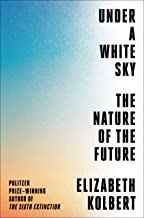Under a White Sky: The Nature of the Future by Elizabeth Kolbert 2021
Kolbert, a staff writer for The New Yorker and a Pulitzer Prize winner for her last book ‘The Sixth Extinction’, has written another important, readable, and engaging book about the world we live in and are, sadly, gradually destroying
This is not a happy book as Kolbert moves from water, to land, to air in three sections entitled Down the River, Into the Wild, and Up in the Air. In each, she uses specific examples and fascinating individuals to educate the reader about the Anthropocene, the name coined to describe the geological period in which we live. Anthropocene, translated as Man’s Period, refers to the fact that humans have changed nature in extra-ordinary and almost always negative ways in the 10,000 years since agriculture and population centers emerged.
The first story in the book tells the tale of the Chicago River whose course was reversed by a huge public works project to create a canal in the late 19th C so that the River flowed south from Lake Michigan instead of north into the Lake. The purpose was to take Chicago’s waste material and stockyards’ effluent to the Mississippi River instead of having it pollute Lake Michigan. That maneuver inadvertently connected the two major watersheds in America, the Mississippi River and the Great Lakes and provided access for invasive species to move between and endanger both watersheds. Asian carp are the big problem today but dozens of other species also are threatening the ecosystem. The responses from the Army Corps of Engineers have varied from poisons to electric barriers—nothing seems to have fixed the problem.
Kolbert goes on to use this approach to examine the flooding of New Orleans and the loss of thousands of square miles of southern Louisiana due to diversion of the Mississippi and its annual land-building silt, the loss of species in the desert due to development that drains aquifers, the world-wide loss of reef systems which are the richest site of species diversity on earth, cane toads introduced into Australia to control beetles but which have eliminated much of the native fauna, genetically altered mice and mosquitos, and geoengineering solutions to global warming.
It’s a fascinating story enriched by Kolbert’s fine writing and well-chosen metaphors. Her conclusion is that even if we wanted to stop man’s interfering with nature, there’s no going back and the choice is either more intervention or watching the earth gradually degrade. As she writes in the conclusion: “This has been a book about people trying to solve problems created by people trying to solve problems.”
As new technologies arise like gene editing with CRISPR, genetically-modified organisms from corn to mice, seeding the stratosphere with diamond particles to reflect sunshine away from the earth (the white sky that would result provided the title for the book), protecting or abandoning our coastal cities due to rising sea levels, and reducing the rate of extinction of rare species, it will be critical to keep in mind our history of great ideas gone wrong. On the other hand, it increasingly appears that we will need new great ideas to be able to extend the presence of humans on earth beyond our measly few hundred thousand years in the earth’s history of 3.5 billion.
This, like Kolbert’s other books, is an important one to read and think about.



